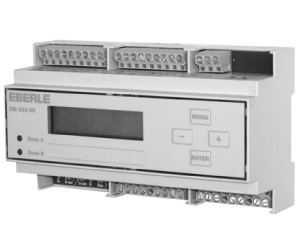The switching process uses the values measured on several temperature and humidity sensors. The algorithm of the regulator evaluates the conditions for turning on. In the following table you will find the summary of sensors, that can be connected to the regulator. The regulator is positioned onto the DIN ledge in the switchgear and initiates the heating cables using the output relay either directly, or through a suitable contactor. A malfunction of the regulator or sensors is signalized by a contact of the second relay.
 EM 524 89
EM 524 89
 EM 524 90
EM 524 90
| EM 524 89 | EM 524 90 | |
| Supply voltage | 230 V AC | |
| Input | ≤15 VA | ≤25 VA |
| Housing | IP 20 | |
| Installation | onto the DIN ledge | |
| Dimensions | 106 x 90 x 58 mm | 159 x 90 x 58 mm |
| Display | 2 x 16 symbols | |
| Control | 3 buttons | 4 buttons |
| Regimes | surfaces, roofs | |
| Range of temperature measurement | -45 až +78°C | |
| Range of humidity measurement | 0 to 9 (relative data) | |
| Inputs | for all sensors | |
| Outputs: | ||
| Heating | relay startup contact 250 V AC/16 A | startup contacts 2 relays 250 V AC/16 A |
| Alarm | relay switching contact 250 V AC/2 A | |
| Sensors: | ||
| ESF 524 001 / 011 | heated humidity sensor for surfaces | |
| TFF 524 002 / 012 | not-heated humidity and temperature sensor for surfaces | |
| ESD 524 003 | heated humidity sensor for roof gutters | |
| TFD 524 004 | air temperature sensor | |
Application
Gutter heating
Heating of outdoor surfaces
References
Documents for download
524 89 (de, gb) catalogue sheet
Manual 524 89 (cz)
Manual 524 89 (en)
Manual 524 89 (sk)
CE agreement declaration 524 89
524 90 (cz) catalogue sheet
Manual 524 90 (cz)
Manual 524 90 (de)
For the switching of simple gutter and outdoor surface heating systems, a simple device can be used - the DTR-E 3102 double bimetallic spatial thermostat. This thermostat initiates heating in a set range of outside temperatures, for example -7 to +5°C. In this range of outdoor temperatures, melting of snow and ice is most common, so during this time it is best to heat. Out of this extent (under -7°C and over +5°C), melting isn´t so frequent and heating isn´t necessary.




